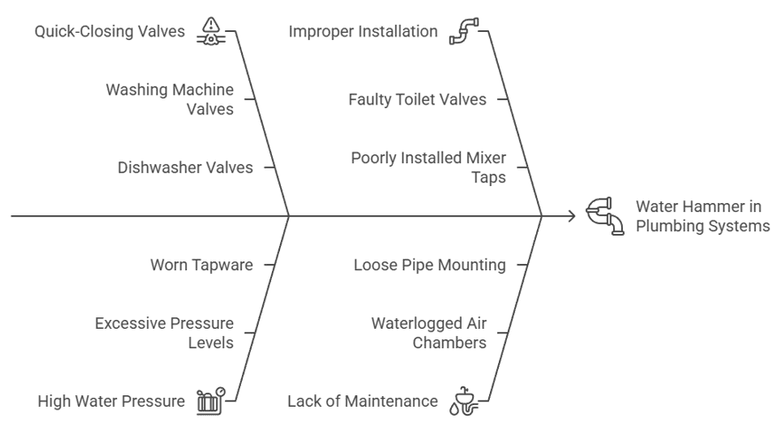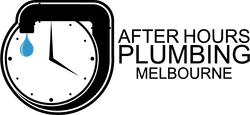Before you think it’s just an annoying noise you can live with, let me tell you something as a licensed plumber who’s been dealing with this stuff for years around Melbourne’s western suburbs - that banging is actually your plumbing system slowly destroying itself.
Water hammer isn’t just noise. It’s hydraulic shock, which is basically pressure waves slamming into your pipe walls, joints, and fixtures every single time it happens. I’ve seen what this does over time. Cracked joints, failed seals, and eventually burst pipes that flood your house at 2am on a Sunday. The emergency callouts I do for burst pipes - probably half of them trace back to water hammer that homeowners ignored for months or years.
What actually causes water hammer in your home
Water hammer happens when fast-moving water suddenly stops or changes direction in your pipes. Think about what happens when you slam on the brakes in your car - all that momentum has to go somewhere. Same thing happens in your plumbing.
Most of the time, it’s your appliances causing the problem. Washing machines and dishwashers have these solenoid valves that shut off water flow in milliseconds. One second water’s rushing through your pipes at full pressure, next second it hits a brick wall. That creates a pressure wave that travels back through your system until it slams into something solid.
But I’ve also seen it caused by worn tap washers, faulty toilet fill valves, and those fancy mixer taps that people love but aren’t always installed properly. The bigger issue isn’t the bang you hear - it’s what that shock wave does to every joint and connection in your plumbing system.
Causes of water hammer

Quick closing valves are usually the culprit
Your washing machine valve closes faster than you can blink. Same with dishwashers. These appliances need to control water flow precisely, so they use electronic valves that can shut off instantly. Problem is, your pipes weren’t designed for that kind of sudden pressure change.
I’ve walked into laundries where the pipes are literally dancing behind the wall every time the washing machine cycles. That’s not just noise - that’s your plumbing system getting hammered with pressure spikes that are gradually loosening every connection.
High water pressure makes everything worse
Most properties around Melbourne get water at pretty high pressure. Your house only needs about 200-250 kPa for everything to work properly, but I regularly test systems running at 400-500 kPa. That extra pressure doesn’t make your showers better - it just makes water hammer more violent and destructive.
High pressure also wears out your tapware faster, makes toilets run, and puts stress on every single connection in your house. It’s like having your entire plumbing system constantly under strain.
Professional solutions that actually work long term
Here’s the thing about water hammer - there are temporary fixes, and there are permanent solutions. Most of what you’ll find online focuses on quick fixes that might work for a few months. As someone who’s installed hundreds of proper water hammer solutions, let me tell you what actually works.
Water hammer arrestors - the real solution
The gold standard fix is installing water hammer arrestors that comply with Australian Standard AS 5200.007-2008. They’re purpose-built devices with a sealed piston system that absorbs pressure spikes permanently. Modern arrestors have an air-filled cylinder that compresses when pressure spikes hit. Unlike the old-style ones that gradually fill with water and stop working, quality arrestors maintain their effectiveness for years. I typically install them right at problem appliance connections - one on hot, one on cold - or throughout the house for complete protection.
Sizing matters. Most residential jobs need 12mm arrestors, but if you’ve got an older house with large-bore pipes, you might need 20mm units. Get the sizing wrong and they won’t absorb enough shock to make a difference. The installation needs to be done properly too. You can’t just screw them onto any old fitting and expect them to work. They need to be positioned correctly, with proper support, and the connections have to be done right or you’ll end up with leaks down the track.
Pressure regulation fixes the root cause
Installing a pressure limiting valve is often the most effective long-term solution because it addresses the underlying problem. These valves go at your water meter and reduce the pressure throughout your entire system. I’ve found that getting pressure down to around 250 kPa not only stops water hammer but also extends the life of everything in your house that uses water. Your appliances last longer, taps stop dripping as much, and you actually use less water overall.
The valves are adjustable, so we can fine-tune them for your specific situation. Some houses need different settings depending on the age of the plumbing and how the system’s laid out.
Proper pipe securing stops the banging
Sometimes the water hammer noise is amplified by loose pipe mounting. If your pipes aren’t secured properly, minor pressure pulses turn into major banging as the pipes knock against wall frames or each other. Proper securing means brackets every 1.2 to 1.5 metres on horizontal runs, every 2.4 metres on vertical runs. The brackets need to be tight enough to prevent movement but not so tight they crush the pipe. Material compatibility is crucial. Never use steel straps on copper pipes - the different metals cause galvanic corrosion that’ll give you leaks. Use copper or plastic-coated straps. For pipes running through walls where you can’t get brackets, foam pipe insulation works well for dampening vibration.
System pressure testing and professional diagnosis
Real water hammer diagnosis involves more than just listening to where the noise comes from. We use pressure testing equipment to measure exactly what’s happening in your system, where the shock waves are coming from, and how severe they are.
Sometimes what sounds like water hammer is actually something else. I’ve been to jobs where people were convinced they had water hammer, but it turned out to be loose pipe mounting, worn valve washers, or even pump problems. Professional diagnosis also involves mapping your system to work out the most effective arrestor placement. Just sticking them anywhere won’t necessarily solve the problem. You need to understand how pressure waves travel through your particular plumbing layout.
DIY fixes vs when you need a professional
Let me be straight with you about what you can do yourself and when you need someone licensed.
What you can try yourself
If you’ve got basic plumbing skills, there are a few things worth trying before calling a professional.
Basic pipe securing is DIY-friendly if the pipes are accessible. Adding foam insulation around loose pipes, tightening existing brackets, or adding new brackets where pipes are obviously loose can help reduce the banging. Adjusting your pressure reducing valve is possible if you’ve already got one installed and it’s accessible. They usually have a screw adjustment that you can turn to reduce pressure. Just don’t go crazy with it - you still need adequate pressure for your fixtures to work properly.
When professional installation is essential
Arrestor installation looks simple but there’s a lot that can go wrong. Sizing, positioning, support, and proper connection all matter. Get any of these wrong and you’ve wasted money on parts that don’t work, or worse, created leak points that’ll cost you later.
Code compliance is another issue. Professional installation ensures everything meets the Plumbing Code of Australia requirements and maintains your insurance coverage. DIY plumbing work that causes damage later can leave you with insurance headaches.
System evaluation and pressure testing require professional equipment and experience. Working out why you’ve got water hammer and what the most effective solution is needs someone who understands hydraulics and has seen hundreds of different system configurations.
Gas work is obviously a no-go for DIY. If your water hammer involves gas hot water systems or requires work near gas lines, that’s licensed tradesman territory.
Preventing water hammer before it becomes a problem
Prevention is always better than repair, especially when repair might involve replacing damaged pipes behind walls.
System design and quality components
If you’re renovating or building new, specify slow-closing valves and proper arrestor placement from the start. It’s much cheaper to prevent water hammer than fix it later. Quality tapware makes a difference too. Cheap taps with worn washers or poorly designed closing mechanisms are more likely to cause sudden pressure changes. Invest in quality ball valves or ceramic disc valves that close gradually.
Proper pipe sizing during installation prevents a lot of hydraulic problems. Undersized pipes create high velocity flow that makes water hammer worse when it hits restrictions.
Regular Maintenance and Early Intervention
Annual pressure testing and system inspection can catch problems before they become expensive. Most homeowners never think about their plumbing until something goes wrong, but a bit of preventive maintenance saves a lot of money.
If you start hearing minor water hammer noises, address them straight away. The longer you leave it, the more damage those pressure spikes are doing throughout your system. What starts as a minor annoyance can end up costing thousands when pipes start failing.
Recognising the warning signs
Water hammer usually starts small and gets worse over time. If you’re hearing occasional banging that’s becoming more frequent or louder, that’s your plumbing system telling you it needs attention. Other signs include fluctuating water pressure, taps that are hard to turn off completely, or appliances that seem to be cycling water flow differently than they used to. These can all indicate developing pressure problems that’ll eventually become water hammer issues.
The real cost of ignoring water hammer
I’ve done too many emergency callouts where water hammer damage could have been prevented with a couple hundred dollars worth of arrestors. Burst pipes behind walls, failed appliance connections, damaged fixtures - it all adds up fast.
Emergency plumbing work always costs more than planned maintenance. When a pipe bursts at 2am, you’re not shopping around for quotes. You’re paying whatever it takes to stop water pouring into your house. Water damage from burst pipes is often worse than the plumbing repair itself. Flooded rooms, damaged flooring, ruined furniture, mould problems - insurance might cover some of it, but the hassle and disruption is something you can avoid entirely.
The thing about water hammer is that it’s completely solvable. With proper arrestors, pressure regulation, and professional installation, you can eliminate the problem permanently. Whether you need a simple arrestor installation or complete system evaluation, fixing water hammer properly saves money and prevents the kind of plumbing emergencies that wreck your weekend.
Why professional installation makes sense
I’m not trying to sell you something you don’t need. Simple air chamber drainage or basic pipe securing might solve minor water hammer temporarily. But if you want a permanent solution that actually works and comes with proper warranty coverage, professional installation is worth the cost.
Licensed installation ensures compliance with Australian standards and maintains your insurance coverage. More importantly, we’ve got the tools and experience to diagnose exactly what’s causing your water hammer and fix it properly the first time.
The other thing is that water hammer solutions need to be matched to your specific system. What works in one house might not work in another, depending on pipe layout, pressure levels, and what appliances you’ve got. Professional assessment takes all that into account.
If you’re dealing with water hammer around Melbourne’s western suburbs, don’t let it turn into an expensive emergency. Proper diagnosis and professional installation of quality arrestors will solve the problem permanently and protect your plumbing investment for years to come.
For professional water hammer solutions and same-day service throughout Werribee and the western suburbs, contact After Hours Plumbing. We’ll assess your system properly and fix the problem right the first time.












































